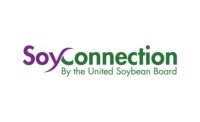The Soy Luck Club
By Maria Pilar Clark
The story unfolds with a tiny 5,000-year-old bean known to the Chinese as a “sacred grain.” The unassuming soybean once struggled to blossom and establish itself in the United States as an essential staple. Today, the soybean’s American-grown descendants have gained the title “sacred grain” once again. The soybean has become the leading provider of protein and oil in the world, and more consumers are joining the proverbial “soy luck club,” in an effort to reap the impressive health benefits this humble little bean has to offer.
The Softer Side of Soy
Close your eyes and picture crumbly golden corn muffins, piping hot from the oven. Or maybe some chewy blueberry muffins are more your thing. Doesn’t a nice fluffy stack of apple cinnamon pancakes make your stomach rumble? Guess what. All of those tasty treats contain soy — which is good for your health too.
Don’t let the soybean’s appearance fool you. That hard little shell and deep brown hue are only the tip of the pagoda. The versatile bean is throwing culinary caution to the wind and being adapted for use in a wide range of bakery applications.
“Soy improves the quality of baked products by keeping them fresher longer than usual,” says Mian Riaz, Ph.D., head of the Extrusion Technology program at the Food Protein R&D Center at Texas A&M University. “Soy flour contains non-fermentable reducing sugars. During baking, these sugars combine to crust browning. In puff pastry, soy (3% to 5%) increases absorption … [and] enhances dough strength … [and] oven spring. In cake doughnuts, soy flour increases water absorption and retention and decreases fat absorption during frying. In sandwich buns, soy flour increases crumb resiliency, and the bun holds together better [during consumption].”
Charlie Morris, manager of Arkady Research for ADM Milling, Olathe, Kan., adds, “The active enzyme in soy flour has been used for many years as a crumb whitener. Also in donuts, soy flour has been used to control oil absorption. We are seeing the [added] use of soy because of its health benefits.”
Soy is making its mark in more than just bakery applications. Jean Heggie, marketing leader for the Solae Company, North America, notes, “[The] use of soy protein is quite prevalent in the nutrition/energy bar segment, where it delivers high-quality protein as well as health benefits. This category has grown dramatically over the last few years as consumers seek more convenient, portable and nutritious on-the-go snacks. Other areas in grain-based foods, which are developing are other forms of hand-held snacks, including soy chips, crisps, trail mixes, etc.”
Riaz agrees, saying, “Domestically, soy-based energy bars are on the rise. In other parts of the world, soy in baked goods is an even hotter item. For example, in Turkey, Egypt, Russia, Jordan and India, usage of soy in bakery applications in growing.”
The breakfast category is experiencing rapid growth as well, as consumers clamor for more soy protein to boost the nutritional content of their morning choices. And what better way to do that than with soy, which Morris says contains nine essential amino acids and is considered a balanced protein.
Consumers are looking for more fortified products, among those, cereal, crackers and cookies. As consumer demand is growing, new applications that highlight the nutritional benefits of soy are continuously emerging.
Heggie explains, “We have found in our research that the idea of getting more protein at breakfast in a convenient form resonates very strongly with consumers. [They] are recognizing the satiety benefits that foods higher in protein can offer in making them feel full longer and manage their hunger.”
Terry Gieseke, of Kerry Ingredients, adds: “Soy is a hot ingredient in a wide range of food applications. Recent studies have shown it at the top of the list for ingredients [that] product developers are working with for three years running.”
Several companies are working hard to answer the call for healthier products fortified with soy. Dan Lampert, Cargill DSONA Technical Services notes, “There are a number of companies, institutions and organizations working on the modification of soybean oil’s fatty acid composition. The primary focus is to ... improve the stability of the oil to reduce or eliminate the need for hydrogenated [oil] for many applications.”
Gieseke says, “Integrating soy into bakery applications is an opportunity with strong growth potential, particularly now as [Kerry’s] Nutriant launches whole-grain soy flour in both full and reduced-fat versions. This allows bakers to build on the healthy positioning values of soy while counting it as part of the whole-grain inclusion requirement. Perhaps, more importantly, at levels of inclusion that allow health and nutrient content claims, this whole-grain soy flour delivers great taste and functionality.”
The use of soy protein isn’t new, and bakers have been incorporating the ingredient into bakery applications for years. Soy performs as a functional ingredient or can act as a replacement for costly egg and milk proteins. Re-formulating is relatively easy, because of the many options soy offers.
In fact, soy proteins, either in the powder or nugget form, are the most commonly used ingredient types, according to Heggie.
“The recommendation to use one versus the other will depend on the application and end product characteristics that the formulator is trying to achieve,” Heggie explains.
Bakers also benefit from the fact that soy is very economical compared to proteins such as milk and eggs.
“Other benefits are improvements in crust color, crub moisture and product shelf life,” Riaz says.
Moreover, soy is very a stable commodity in terms of forecasting price fluctuations, Riaz explains.
“The addition of soy flour enhances profitability through more dough yield, lower dough cost, improved product quality and increased shelf life,” Riaz explains. “In cookie dough, we can replace liquid whole eggs with lecithinated soy flour, and this will bring the cost of ingredients much lower than using the whole liquid eggs.”
Gieseke adds, “[Soy’s] inclusion can count toward the daily value for protein on nutrition labels. … When soy is used in place of milk or egg, it has strong economic value. Some soy ingredients — including Nutriant’s whole-grain soy flour, traditional soy flour, concentrate and fiber products — also contribute dietary fiber and can be used at inclusion levels that support ‘good source’ or ‘excellent source of fiber’ claims.”
Additionally, integrating soy into bakery applications is not a challenge. Bakers can use the same equipment when formulating with soy and a variety of ingredients are available.
Morris says, “There are different kinds of soy ingredients, such as defatted soy flour, full fat soy flour, enzymes-active soy flour and so forth.”
Furthermore, Riaz debunks a myth that soybeans infiltrate baked goods with an unpleasant, “off” flavor. Riaz explains that if soybeans are properly processed, there shouldn’t be a strange soy taste to products.
“The flavor comes from lipoxygenase enzymes. During the processing of whole soybeans into soy flour, the heat treatment destroys these enzymes,” she says.
Additionally, Morris notes that the use of honey and molasses can be used to mask the color and flavor of soy products.
In a nutshell, soy’s natural goodness, imperceptible taste and versatility and the resilience of the crops make it an emperor among other ingredients — in the U.S. alone, soybean oil represents approximately 79% of all edible oil consumed.
Building a Better Bean
As the soybean industry gathers steam, emerging research is a hot topic — specifically in the area of developing new varieties of the bean that are low in linolenic acid.
According to Riaz, “The soybean industry is working to accelerate the development and commercialization of soybeans with enhanced traits through an industry initiative called QUALISOY.”
QUALISOY is a one-of-a-kind agricultural initiative, formed to improve the development and competitiveness of new U.S. soybean varieties. The aim is to “build a better bean” through the cultivation of healthier soybeans and soybean oil; and by enhancing the bean’s quality and nutritional benefits while preserving the environment and maintaining a competitive atmosphere throughout the industry.
According to the QUALISOY Fall 2004 e-newsletter, the first, goal-setting phase of the Better Bean Initiative (BBI) was completed, and the United Soybean Board (USB) recognized a need to establish a Board of Directors for QUALISOY.
The USB formed a 22-member board that is a working hub of farmers, researchers, representatives from multinational seed and chemical companies, regional agricultural companies, processors, food companies and food and feed industry associations.
David Durham, chairman of the board for QUALISOY, notes, “One of the Board’s primary objectives is to facilitate industry-wide cooperation and encourage a spirit of collaboration. The diversity of the group ensures varying perspectives and representation of virtually every interest throughout the value chain.”
Riaz suspects that QUALISOY’s first triumph could be against trans fat.
“The low-linolenic soybeans developed through QUALISOY will produce more stable oil without hydrogenation,” Riaz says. “The resulting oil will have less or no trans fatty acids.”
Riaz also expects that soybeans with mid-oleic acid levels will be introduced to the baking industry in the near future.
Babes in Soyland
Introducing soy into children’s diets is a very efficient way to increase their intake of quality protein on a regular basis. Many children naturally take to soy because of its ability to add moistness and flavor to many traditional foods including bread, pasta and desserts (the three favorite food groups of most little ones). Regular consumption of soy protein could even reduce their risk for some cancers, heart disease and osteoporosis.
Soy also has important health benefits for older children. Two studies presented to the American Dietetic Association concluded that teenagers who consume soy as a part of their daily diet, could significantly reduce their risk for breast cancer.
It’s good to get children enjoying soy at an early age, because often prevention is a key factor in maintaining health and wellness.
According to the American Heart Association’s 2002 Statistical Update, 61.8 million Americans have some form of cardiovascular malady, and nearly 960,000 of those people died in 1999. That translates to one out of every 2.5 deaths in the U.S. being caused by some form of cardiovascular disease. Since 1918, heart disease has maintained its rank as the No. 1 killer in the United States.
To this end, the Food and Drug Administration approved a health claim regarding soy protein in October 1999, stating that 25 gm. of soy protein consumed daily could lower the risk of coronary heart disease. In order to meet the criteria of a “heart healthy” product, food products must contain 6.25 gm. of soy protein per serving and be low in saturated fat, sodium and cholesterol.
Riaz explains that most bakery applications do not use the health claim regarding soy on their packaging, since formulations contain only 3% to 6% soy flour. However, one exception is Cargill, which has a patent on a bread product “containing enough soy protein to carry the health claim,” Riaz says.
Lampert explains the benefits: “The lowering of linolenic fatty acid in soybean oil will have a positive effect on … anyone using generic salad oil in their formulations. If lightly hydrogenated soybean oil is used, the formulation may work with the low linolenic salad oil, resulting in slightly lower saturates and more significantly reduced trans [fat].”
Riaz explains that even if a product cannot meet the soy health claim, consumers will still find that products are fortified with some level of soy protein. Gieseke says that fortification makes those products appealing because of a healthy image.
“Consumer interest in soy as a front panel declaration is growing,” Gieseke says. “Soy can contribute to nutrient content positions — ‘good’ or ‘excellent’ source of protein and/or fiber — and currently there is a positive response to ‘heart healthy’ positioning.”
In the early 1900s, the United States was importing 40% of its edible fats and oils from abroad. During the World War II era, oil became scarce, forcing farmers to turn to other options, primarily soybean oil. From then on, soybean crops were recognized as a “cash cow” for the U.S., which was exporting 78 million bushels by 1940.
Today, farmers in more than 29 states plant and grow soybeans — the second largest crop in cash sales and a No. 1 export.
The soybean has come a long way from its ancestral roots, and is continuing to grow strong while preserving the lasting dynasty it has created for consumers and manufacturers alike.
Editor’s Note: For more information on soybeans and soybean products, visit the United Soybean Board’s Web site, www.talksoy.com. To read more about the QUALISOY initiative, visit their Web site at www.qualisoy.com or email info@qualisoy.com.
With legendary Chinese origins, the soybean has become a “proteinaceous” powerhouse that, among other things, can boost cardiovascular health and improve your products’ image.
Fu Shou For You
The Chinese words fu and shou mean “good luck” and “longevity,” respectively. Fittingly, soy protein provides such numerous health benefits, that consuming soy products could ensure that fu and shou become synonymous with cardiovascular health.
Jean Heggie, marketing leader, North America, for the Solae Company notes, “The nutrition research supporting the health benefits of soy protein continues to evolve. The heart-health benefit of soy protein is well-established and recognized, as evidenced by the 1999 Food and Drug Administration (FDA) Soy Protein and Heart Health Claim. But new research in this area is indicating that soy protein may provide benefits in promoting arterial health, as well as cholesterol reduction.”
The FDA formally acknowledged the cholesterol-lowering effects of soy protein in 1999, with the American Heart Association following suit one year later. The FDA-approved health assertion claims that 25 gm. of soy protein daily may reduce the risk of heart disease.
Terry Gieseke of Kerry Ingredients says, “Clinical studies continue to understand the potential impact of soy proteins and bioactive components on several aspects of health.”
For example, current research suggests that soy may lower the risk of colon, prostate and breast cancers in addition to lowering the risk for high blood pressure and osteoporosis, and giving menopausal women relief from their symptoms.
Heggie adds, “Data supporting soy protein’s benefit for bone health and cancer prevention continues to grow. Other areas of research, which are emerging, include benefits relative to diabetes and blood glucose management, weight management, performance nutrition and cognition.”
This latest “miracle crop’s” health-enhancing benefits are spurring on the growth of functional “super foods” around the country, all implementing soy.




